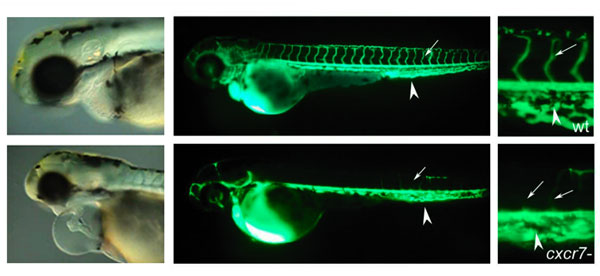Fig. 7
CXCR7 plays a role in vascularization and angiogeneisis in zebrafish. Given the high expression levels of CXCR7 on tumor vasculature, we wished to assess whether this receptor played a role in blood vessel formation and development. Zebrafish provide an accessible system to examine the effect of genetic manipulation of CXCR7 during development. CXCR7-specific antisense morpholinos (MOs) were injected into zebrafish embryos to inhibit the expression of the CXCR7 transcript. Examination of MO-injected embryos at 56 h after fertilization demonstrated a clear cardiac defect, and a lack of circulating blood (Left and SI Movies 1-4). In addition, a variety of vascular defects were noted in the CXCR7-knockdown embryos as determined by microangiography using FITC-dextran injection to visualize functional vasculature (Center and Right). Specifically, knockdown embryos showed gross defects in vasculogenesis of the axial vessels and little or no circulation of FITC-dextran dye in the trunk or tail. In addition, deficiencies were observed in the vessels formed by sprouting angiogenesis. Moreover, many CXCR7 knockdown embryos showed defects in the intersegmental (IS) vessels that form by angiogenesis from the dorsal aorta (arrows, Center and Right). Additionally, the vascular plexus of the caudal vein in the tail was also malformed in CXCR7-/- embryos revealing a single fluid-filled cavity instead of the normal, intricate vascular bed that is seen in control embryos (arrow heads, Center and Right). Taken together, MO-mediated knockdown of the zebrafish CXCR7 gene resulted in embryos displaying defects in cardiac development, vasculogenesis and angiogenesis. These observations support a requirement for CXCR7 in vascular formation and angiogenesis during development and provide a possible link to CXCR7′s role in the formation of tumor vasculature.

